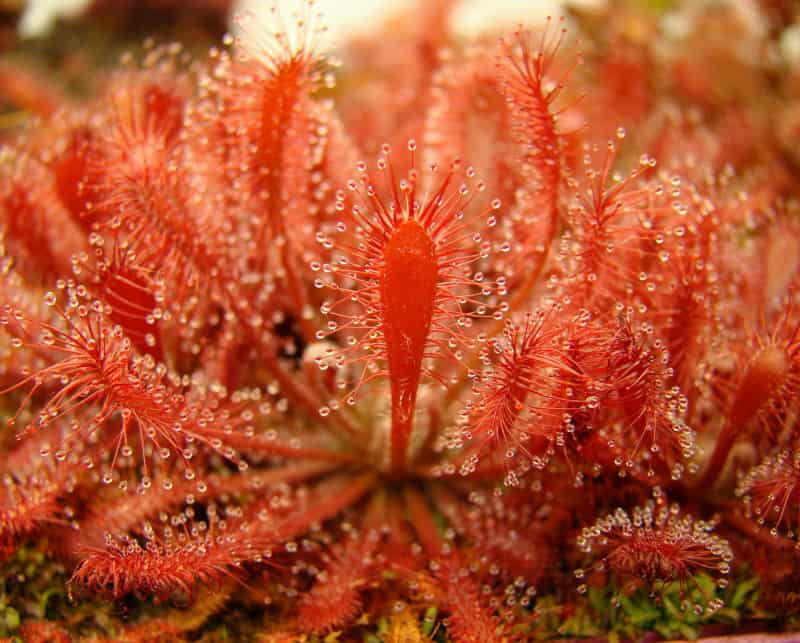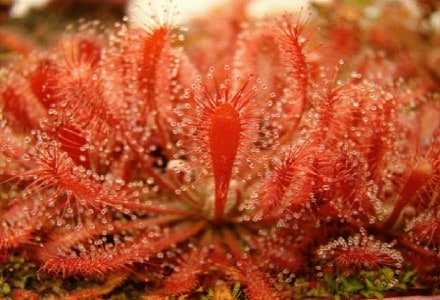
Photo Credit: Damien Wu
Public Domain Image
Sundew Facts
- Firstly, the simple term of Sundew serves as the collective common name for any member of a relatively large genus of plants. Secondly, and perhaps more uniquely, every one of them evolved as carnivorous in nature. Thirdly, science currently recognizes a total of 194 species in this remarkable grouping. However, this number could change, since other plants remain under evaluation.
- Furthermore, the simple fact of being classified together means that each of the species in the genus share certain physical characteristics. In the case of these particular types of flora, that pertains to the manner in which they trap their prey. That holds true because all members of this group capture and digest insects via sticky glands on the surface of the leaves.
- In addition, the name Sundew also derives from another mutually shared trait. That’s the fact the drops of a form of mucilage present on the exterior of the leaves. These drops accumulate at the tips of the foliage of all known forms of these plants. The various types also vary significantly in form and size. The genus also occurs on every continent except Antarctica.
Related Articles
Cobra Lily Butterwort Waterwheel Plant
Sundew Physical Description
Yet another characteristic remains shared by most forms of the marvelous Sundew. This one, however, pertains to their lifespan. That’s because most plants placed in this genus evolved as perennials. Nevertheless, a few species evolved as annuals. But, regardless of this character of their nature, all of them qualify as herbaceous plants.
Further, given the simple fact that the term applies to so many different individual species, one statistic remains variable. This occurs because physical characteristics quite naturally vary. In addition, this includes both appearance and sheer size. Also, to be certain, the differences in dimensions can be quite pronounced.
This holds true due to the fact the various types of Sundew range quite significantly in size. But, to be more precise, this factor varies from 0.4 – 39 in (1-100 cm) in overall height. Also, the flowers of these fascinating plants develop high above the leaves. Further, in the majority of the different types, the flowers display either white or pink.
- Kingdom: Plantae
- Phylum: Angiosperms
- Class: Eudicots
- Order: Caryophyllales
- Family: Droceraceae
- Genus: Drosera
Public Domain Image
Sundew Distribution, Habitat, and Ecology
The truly impressive Sundew has a nearly global range. In point of fact, the genus occurs as far north as portions of Alaska, in the United States. Further, to the south, its range also extends as far as the country of New Zealand. Yet, the greatest diversity of species within the group still exists in Australia. That stands as true due to the remarkable fact that roughly half of all the presently recognized species live there.
Furthermore, though, other regions of the world also have their share of these incredibly evolved carnivorous plants. To be more precise, both southern Africa and South America each serve as home to 20 known varieties of Sundew. Additionally, the continent of North America also remains home to four endemic species of these plants. Yet another three forms of this fabulous plant evolved in Europe.
However, wherever they appear, each shares a habitat requirement. That’s because the Sundew typically appears in very wet habitats, with high levels of sunlight and acidic soil. A few types even acquire needed nutrients entirely from the insects consumed. Some varieties also evolved as climbing plants. These sometimes form stems that grow even taller than this. Finally, a few of these unique plants even live as long as 50 years.
Species Sharing Its Range
Wood Frog Scottish Wildcat Bristlecone Pine
Check out our other articles on 7 Supremely Scintillating Cnidaria, Bee Hummingbird, McMurdo Dry Valleys, Pink Fairy Armadillo, Green Orchid Bee, Basking Shark, Wood Frog

